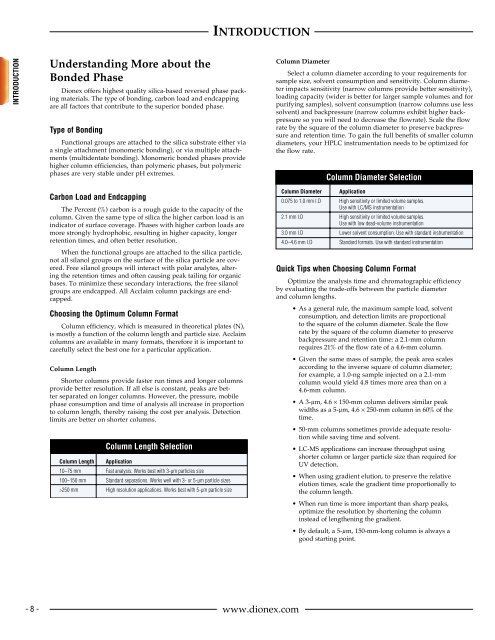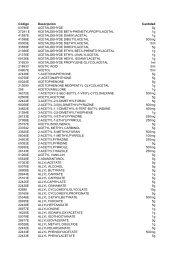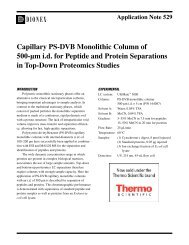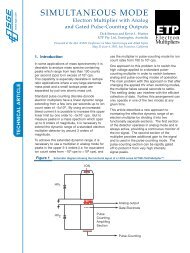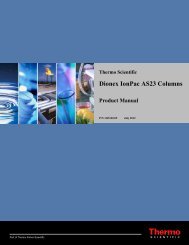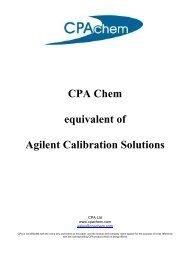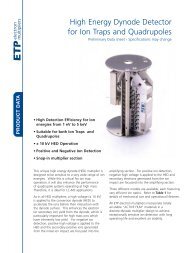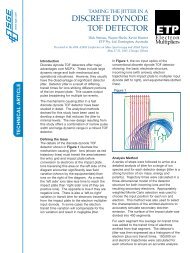ACCLAIM oa - Cromlab
ACCLAIM oa - Cromlab
ACCLAIM oa - Cromlab
You also want an ePaper? Increase the reach of your titles
YUMPU automatically turns print PDFs into web optimized ePapers that Google loves.
IntroductionINTRODUCTIONUnderstanding More about theBonded PhaseDionex offers highest quality silica-based reversed phase packingmaterials. The type of bonding, carbon l<strong>oa</strong>d and endcappingare all factors that contribute to the superior bonded phase.Type of BondingFunctional groups are attached to the silica substrate either viaa single attachment (monomeric bonding), or via multiple attachments(multidentate bonding). Monomeric bonded phases providehigher column efficiencies, than polymeric phases, but polymericphases are very stable under pH extremes.Carbon L<strong>oa</strong>d and EndcappingThe Percent (%) carbon is a rough guide to the capacity of thecolumn. Given the same type of silica the higher carbon l<strong>oa</strong>d is anindicator of surface coverage. Phases with higher carbon l<strong>oa</strong>ds aremore strongly hydrophobic, resulting in higher capacity, longerretention times, and often better resolution.When the functional groups are attached to the silica particle,not all silanol groups on the surface of the silica particle are covered.Free silanol groups will interact with polar analytes, alteringthe retention times and often causing peak tailing for organicbases. To minimize these secondary interactions, the free silanolgroups are endcapped. All Acclaim column packings are endcapped.Choosing the Optimum Column FormatColumn efficiency, which is measured in theoretical plates (N),is mostly a function of the column length and particle size. Acclaimcolumns are available in many formats, therefore it is important tocarefully select the best one for a particular application.Column LengthShorter columns provide faster run times and longer columnsprovide better resolution. If all else is constant, peaks are betterseparated on longer columns. However, the pressure, mobilephase consumption and time of analysis all increase in proportionto column length, thereby raising the cost per analysis. Detectionlimits are better on shorter columns.Column LengthColumn Length SelectionApplication10–75 mm Fast analysis. Works best with 3-µm particles size100–150 mm Standard separations. Works well with 3- or 5-µm particle sizes>250 mm High resolution applications. Works best with 5-µm particle sizeColumn DiameterSelect a column diameter according to your requirements forsample size, solvent consumption and sensitivity. Column diameterimpacts sensitivity (narrow columns provide better sensitivity),l<strong>oa</strong>ding capacity (wider is better for larger sample volumes and forpurifying samples), solvent consumption (narrow columns use lesssolvent) and backpressure (narrow columns exhibit higher backpressureso you will need to decrease the flowrate). Scale the flowrate by the square of the column diameter to preserve backpressureand retention time. To gain the full benefits of smaller columndiameters, your HPLC instrumentation needs to be optimized forthe flow rate.Column DiameterColumn Diameter SelectionApplication0.075 to 1.0 mm I.D High sensitivity or limited volume samples.Use with LC/MS instrumentation2.1 mm I.D High sensitivity or limited volume samples.Use with low dead-volume instrumentation3.0 mm I.D Lower solvent consumption. Use with standard instrumentation4.0–4.6 mm I.D Standard formats. Use with standard instrumentationQuick Tips when Choosing Column FormatOptimize the analysis time and chromatographic efficiencyby evaluating the trade-offs between the particle diameterand column lengths.• As a general rule, the maximum sample l<strong>oa</strong>d, solventconsumption, and detection limits are proportionalto the square of the column diameter. Scale the flowrate by the square of the column diameter to preservebackpressure and retention time: a 2.1-mm columnrequires 21% of the flow rate of a 4.6-mm column.• Given the same mass of sample, the peak area scalesaccording to the inverse square of column diameter;for example, a 1.0-ng sample injected on a 2.1-mmcolumn would yield 4.8 times more area than on a4.6-mm column.• A 3-µm, 4.6 × 150-mm column delivers similar peakwidths as a 5-µm, 4.6 × 250-mm column in 60% of thetime.• 50-mm columns sometimes provide adequate resolutionwhile saving time and solvent.• LC-MS applications can increase throughput usingshorter column or larger particle size than required forUV detection.• When using gradient elution, to preserve the relativeelution times, scale the gradient time proportionally tothe column length.• When run time is more important than sharp peaks,optimize the resolution by shortening the columninstead of lengthening the gradient.• By default, a 5-µm, 150-mm-long column is always agood starting point.- 8 -www.dionex.com


